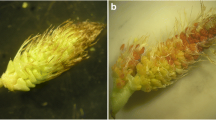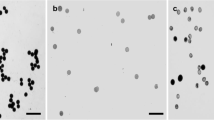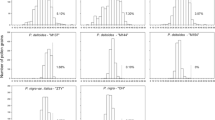Abstract
Segregants which produce 2n pollen were identified inSolanum stoloniferum and hybridized with 2n pollen producing cultivated diploids. A number of the resulting triploids produced 2n pollen, ranging from less than 1 up to 7.6%. Parallel spindles at Anaphase II were shown to be the probable meiotic mechanism responsible for 2n pollen production. Thus the genetic consequences are equivalent to first division restitution. This 2n pollen produced by triploids should facilitate transfer of genes from wild allotetraploids to cultivated tetraploids. There should be increased gene exchange between nonhomologous wild and cultivated genomes during microsporogenesis of the triploids. This methodology should have merit in crosses with allotetraploid species in the Series Longipedicellata and Acaulia.
Compendio
Se identificaron segregantes que producen polen 2n enSolanum stoloniferum y se hibridaron con diploides cultivados productores de polen 2n. Varios de los triploides resultantes produjeron polen 2n, en un rango de menos de 1 hasta 7,6%. Usos paralelos en la Anafase II mostraron ser el mecanismo meiótico probablemente responsable de la producción de polen 2n. Asi, las consecuencias genéticas son equivalentes a la restitución de primera division. Este polen 2n producido por los triploides habrá de facilitar la transferencia de genes de alotetraploides silvestres a tetraploides cultivados. Por lo tanto será incrementado el intercambio entre genomas silvestres no homólogos y aquellos cultivados, en la microsporogenesis de los triploides. Esta metodología será valiosa en cruzamientos con especies alotetraploides en las Series Longipedicellata y Acaulia.
Similar content being viewed by others
Literature Cited
Brown, C.R., L. Salazar, C. Ochoa, R. Chavez, L. Schilde-Rentschier and C. Lizarraga. 1984. Ploidy manipulation of a new source of resistance to PLRV fromSolanum acaule. 9th Trien Conf EAPR, Interlaken, Switzerland, pp. 288–289. Abst.
Den Nijs, Ton P.M. and S.J. Peloquin. 1977. Polyploid evolution via 2n gametes. Am Potato J 54:377–386.
DeVerna, J.W., R.T. Chetelat, C.M. Rick and M.A. Stevens. 1987. Introgression ofSolanum lycopersicoides germplasm. In: Tomato Biotechnology, (eds.) DJ. Nevins and R.A. Jones. Alan R. Liss, Inc., New York. 339 pp.
Dvorak, J. 1983. Evidence for suppression of heterogenetic chromosome pairing in polyploid species ofSolanum, sect.Petota. Can J Genet Cytol 25:530–539.
Everhart, E.R. and P.E. Rowe. 1974. Disomic inheritance of anthocyanins and flavonol glycosides in the tetraploid tuber-bearing speciesSolanum stoloniferum. Am Potato J 51:287–294.
Hawkes, J.G. 1981. Biosystematic studies of cultivated plants as an aid to breeding research and plant breeding. Kulturpflanze 24:327–335.
Jackson, M.T., P.R. Rowe and J.G. Hawkes. 1978. Crossability relationships of Andean potato varieties of three ploidy levels. Euphytica 27:541–551.
Johnston, S.A. and R.E. Hanneman, Jr. 1982. Manipulations of endosperm balance number overcome crossing barriers between diploidSolanum species. Science 217:446–448.
Koopmans, A. 1951. Cytogenetic studies onSolanum tuberosum L. and some of its relatives. Genetica 25:192–337.
Mok, D.W.S. and S.J. Peloquin. 1975. Three mechanisms of 2n pollen formation in diploid potatoes. Can J Genet Cytol 17:217–225.
Mok, D.W.S., S.J. Peloquin and T.R. Tarn. 1975. Cytology of potato triploids producing 2n pollen. Am Potato J 52:171–174.
Ramanna, M.S. 1983. First division restitution gametes through fertile desynaptic mutants of potato. Euphytica 32:337–350.
Rick, C.M., J.W. DeVerna, R.T. Chetelat and M.A. Stevens. 1986. Meiosis in sesquidiploid hybrids ofLycopersicon esculentum andSolanum lycoperskoides. Proc Natl Acad Sci, USA 83:3580–3583.
Ross, H. 1954. Die Verebungder “immunitat” gegen das X-virus in tetraploidem.Solanumacaule. Proc 9th Int Congr of Genetics, Bellagio, II, pp. 1128–1132.
Ross, H. 1958. Inheritance of extreme resistance to virus Y inSolanum stoloniferum and its hybrids withSolanum tuberosum, pp. 204–211. Proc Third Conf Potato Virus Diseases, 1957, Lisse-Wageningen, The Netherlands.
Ross, H. 1986. Potato Breeding—Problems and Perspectives. Verlag Paul Parey, Berlin, Germany. 132 p.
Schmiediche, P.E., J.G. Hawkes and C.M. Ochoa. 1980. Breeding of the cultivated potato speciesSolanum × juzepczukii BUK. andSolanum Xcurtilobum JUZ et BUK. I. A study of the natural variation ofS. ×juzepczukii, S. ×curtilobum and their wild progenitor,S. acaule BITT.
Swaminathan, M.S. and H.W. Howard. 1953. The cytology and genetics of the potato (Solanum tuberosum) and related species. Biblio Genet 16:1–192.
Tarn, T.R. and J.G. Hawkes. 1986. Cytogenetic studies and the occurrence of triploidy in the wild potato speciesSolanum commersonii DUN. Euphytica 35:293–302.
Von Wangenheim, K.-H. 1954. Zur Ursache der Kreuzungsschwierigheiten zwischenSolanum tuberosum L. undS. acaule Bitt. bzw.S. stoloniferum Schlechtd. et Bouche. Z Pflanzenzuchtg 34:7–48.
Author information
Authors and Affiliations
Additional information
Cooperative investigations of the ARS, USDA, and the Washington State University Agriculture Research Center. Prosser, WA 99350. College of Agriculture and Home Economics Research Center, Pullman, WA 99164. Scientific Paper No. 7819.
Rights and permissions
About this article
Cite this article
Brown, C.R. Characteristics of 2N pollen producing triploid hybrids betweenSolanum stoloniferum and cultivated diploid potatoes. American Potato Journal 65, 75–84 (1988). https://doi.org/10.1007/BF02867455
Accepted:
Issue Date:
DOI: https://doi.org/10.1007/BF02867455




